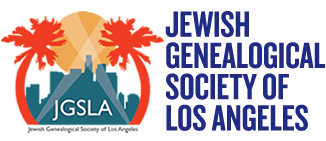Growing up Fairfax, by Sara Hyman
I grew up just south of what people refer to as Fairfax when they talk about the Jewish communities of Los Angeles. South Fairfax Avenue was caught between the vibrant Fairfax of the 1950s and 1960s and the now-vibrant Pico-Robertson area of today. But I knew the Fairfax of the 1960s and 1970s, so here’s a little about that area.
Fairfax is generally considered to be the area centered around Fairfax Avenue between Melrose Avenue and 6th Streeet. How much off the actual Fairfax Avenue is considered as part of the area is dependent on the person speaking. I saw one reference that indicated the Beverly Center (at La Cienega and Beverly) and Cedar-Sinai Medical Center were part of Fairfax, another that implied that it went as far east as the Hollywood-Highland complex. Growing up, neither area was considered Fairfax. Because the blocks on either side of Fairfax Avenue were residential, when someone talked about Fairfax, they usually meant the shops and restaurants on the avenue itself. Sometimes, when “Fairfax” is mentioned, the reference is not specifically to the North Fairfax area as much as it is to a general feeling of Jewishness seen in the Fairfax area. In the 1970s, Fairfax had a wide variety of different types of Jews – religious and secular, seniors and college students, Americans and immigrants from Israel and Russia, among other places.
At the south end is the Los Angeles Country Museum of Art. As you move north, on one side of the street is Park LaBrea, an upscale community of both high-rise and townhouse apartments. On the other side, small storefronts abound, including one of the most famous Irish pubs in the area – Molly Malone’s and at least one orthodox shul. As you continue north, you find the Farmer’s Market, CBS Television City, the Farmer’s Daughter Motel and once upon a time – Kelbo’s Hawaiian Bar-b-q. More recently, Farmer’s Market has been joined by the shopping district called the Grove, which includes in its restaurants: the All American Sausage Company, a kosher hot dog stand.
The next four blocks (between Beverly and Melrose) are the heart of what people mean when they talk about Jewish “Fairfax.” Full of small storefronts, in the 1950s and 1960s, the majority were Jewish, including bakeries, butchers and religious items. In the 1970s, the stores included a Chabad, HaTaklit (a record store with lots of Israeli records) and Jewish Family Service offices. As you continue to Melrose, Fairfax High is on the east side of the street and landmarks on the west side include Canter’s Deli, the Silent Movie Theatre, and the National Council of Jewish Women’s offices.
Just east of CBS Television City and the Farmer’s Market, is Pan Pacific Park, on the site of the old Pan Pacific Auditorium, home of the Los Angeles Holocaust Monument. Joining the monument at the Park this summer will be the Los Angeles Museum of the Holocaust. The previous location of the museum closed in May of this year and, as of early June, they had not announced an opening date for the new location.
The Jewish community of Fairfax began to develop in the early years of the 20th century. Before about 1920 the area was part of Rancho La Brea, so named because of the tar pits, a grant from the Mexican government. In 1870, Arthur Gilmore became the owner of a large section of the Rancho that includes today’s Fairfax. After hitting oil, Gilmore developed a racetrack, a ball field, a bank, and provided the home for the Farmer’s Market (opened in 1934). As the oil wells were going dry, the family sold much of their land and houses, duplexes, and apartment building were built. As this development was going on, the Jews in Boyle Heights and West Adams were looking for new homes. They were joined in “Fairfax” by people moving to Los Angeles from big cities further east. The community continued to attract new residents as World War II approached and passed, but while it had given L.A. a reference for the Jewish community, it was never home to more than a small percentage of them, and was a decidedly middle class neighborhood.
Over the last few decades, Fairfax has lost some of its luster and importance as the Pico/Robertson area, about three miles to the southwest, has increased its number of Jewish institutions, with at least ten kosher restaurants, a Mikvah and several day schools. At the west end of the Pico/Robertson area is the Museum of Tolerance.
As an indication of how things change, going back to the South Fairfax neighborhood of my youth: In the block south of Olympic, in the 1960s there were three Jewish (but treif) delis, two Jewish, trief bakeries, and the original Hansen Cakes. Today that block anchors “Little Ethiopia.” In the block north of Pico, in the 1960s, was an Orthodox Shul (Temple Judea, later merged with Congregation B’nai David in the Pico-Robertson area); today, it’s a Korean church. Just north of Olympic, where I shopped at the Super Yarn Mart, today is Shalhevet High School, a progressive Orthodox high school with coeducational classes.
Sara Hyman is a Mission Assurance Manager at the Jet Propulsion Laboratory (NASAICaITech). A native Angelino, she graduated from Fairfax High and UCLA. She has been working on her family history with her sister, Marsha Hyman Rapp, who lives in Israel, for the past several years.
